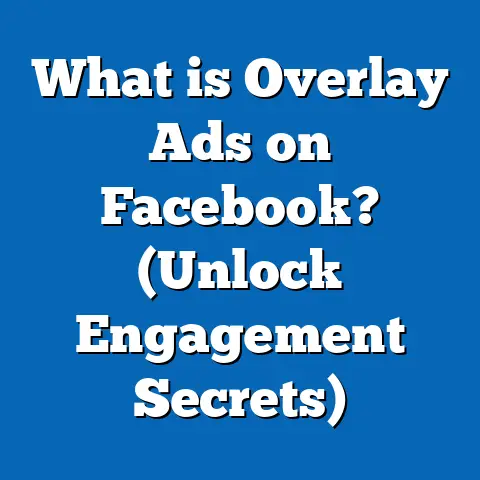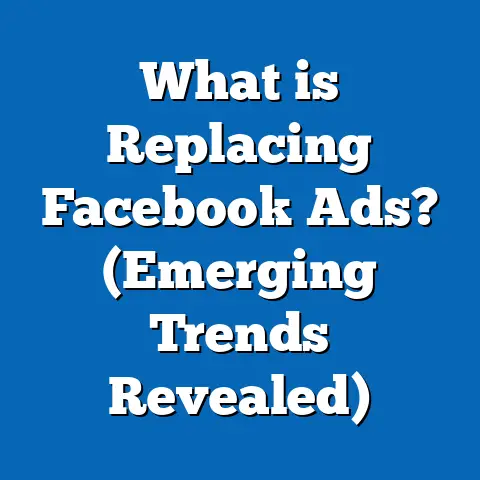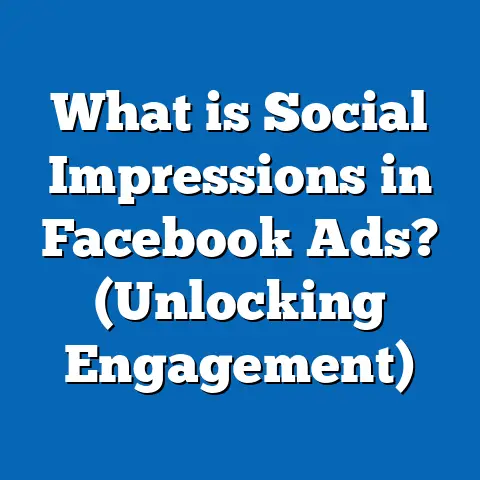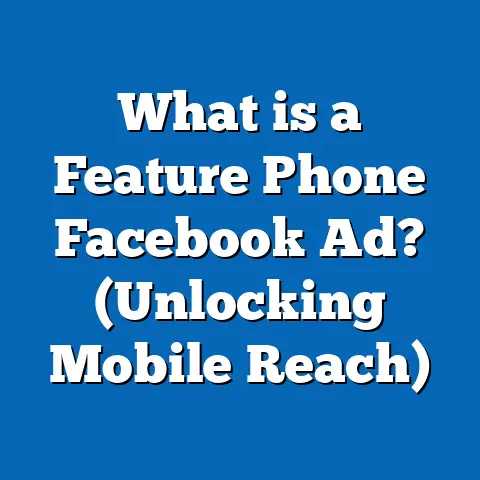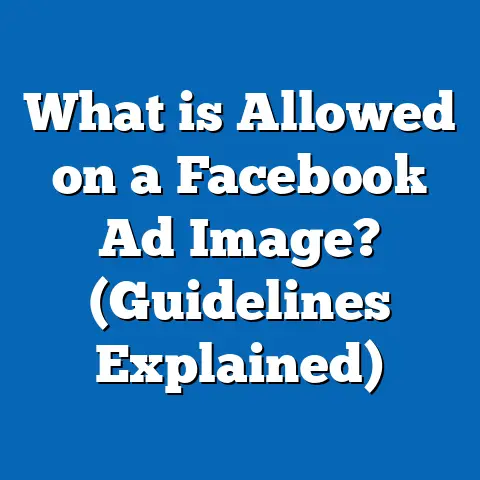What is a Facebook Ad Posting Job? (Unlocking Marketing Potential)
Introduction: Upgrades in Digital Marketing—Why Facebook Ad Posting Jobs Matter
Digital marketing has witnessed constant upgrades, from the early days of banner ads to today’s sophisticated algorithm-driven campaigns. As platforms evolve, businesses must adapt to stay ahead—especially on Facebook, where advertising tools and strategies have dramatically advanced. The surge in automation, granular audience targeting, and creative ad formats has made Facebook advertising both more accessible and more complex. In this dynamic environment, the demand for skilled professionals who can navigate the nuances of Facebook Ad Posting jobs is at an all-time high.
The rise of Facebook Ad Posting jobs represents a pivotal shift in how brands approach online marketing. Understanding what these jobs entail—and how they unlock new levels of marketing potential—is essential for business owners and marketers aiming to harness the full power of Facebook’s ad ecosystem.
What is a Facebook Ad Posting Job?
Defining the Role
A Facebook Ad Posting job typically involves creating, scheduling, optimizing, and monitoring ads on behalf of businesses or clients using Facebook’s advertising platform. These roles can be in-house, freelance, or agency-based and require a mix of creative, analytical, and technical skills.
Key Responsibilities
- Crafting compelling ad copy and visuals
- Selecting appropriate objectives (e.g., traffic, conversions, engagement)
- Targeting specific audiences using Facebook’s detailed demographics and interest data
- Setting budgets and bidding strategies
- Monitoring ad performance and tweaking campaigns for optimal results
How This Role Has Evolved
Over the past five years, the complexity of Facebook advertising has increased. According to Statista, global Facebook ad revenue grew from $39.9 billion in 2017 to $135.9 billion in 2023—a 240% increase. This growth reflects not just increased ad spend but a greater reliance on skilled professionals to manage ever-more intricate campaigns.
Why Facebook? The Platform’s Unique Advertising Potential
Unmatched Audience Reach
With over 3 billion monthly active users as of Q1 2024 (Meta), Facebook remains the largest social platform worldwide. This scale enables advertisers to reach nearly any demographic or market segment.
Advanced Targeting Capabilities
Facebook’s ad manager offers:
- Custom Audiences: Upload customer lists or target website visitors
- Lookalike Audiences: Find new users similar to existing customers
- Detailed Interest & Behavior Targeting: Over 1,000 demographic and behavior filters
These tools enable micro-targeted campaigns that outperform traditional mass media.
Cross-Platform Integration
Facebook ads can appear across Instagram, Messenger, and the Audience Network, multiplying the impact of a single campaign without extra effort.
Core Components of a Facebook Ad Posting Job
1. Setting Up Business Manager & Ad Accounts
Business Manager Overview
Meta Business Manager centralizes asset management—pages, ad accounts, permissions—making it essential for agencies and larger businesses.
Ad Account Setup Steps
- Create a Business Manager account.
- Add your Facebook Page(s).
- Link or create ad accounts.
- Assign team roles with appropriate permissions.
2. Developing Effective Ad Creatives
Types of Facebook Ads
- Image Ads: Simple, effective for awareness
- Video Ads: Higher engagement; 54% of consumers want more video content (HubSpot, 2023)
- Carousel Ads: Showcase multiple products or features
- Collection & Instant Experience Ads: Seamless mobile shopping experiences
Best Practices
- Use high-resolution images (minimum 1080 x 1080 px)
- Clear, concise copy with strong CTAs
- A/B test different creatives to identify top performers
3. Audience Selection & Segmentation
Building Audiences
- Core Audiences: Age, gender, location, interests
- Custom Audiences: Upload lists, website/app engagement
- Lookalike Audiences: Leverage Meta’s AI to expand reach efficiently
Data Points
A study by AdEspresso (2024) found that campaigns with segmented audiences saw a 36% lower CPA (cost per acquisition) than non-segmented ones.
4. Campaign Objectives & Optimization
Choosing Objectives
Options include:
- Brand Awareness
- Reach
- Traffic
- Engagement
- App Installs
- Video Views
- Lead Generation
- Conversions
- Sales
Optimization Techniques
- Use Facebook’s automated bidding for learning phase
- Regularly analyze metrics: CPM (cost per mille), CTR (click-through rate), CPA
- Adjust budgets based on performance data
The Process: Step-by-Step Breakdown of a Facebook Ad Posting Job
Step 1: Client Onboarding and Goal Setting
Clarify the client’s target audience and campaign goals (sales, leads, brand lift). Collect brand assets and previous campaign data.
Step 2: Strategic Planning
Research competitors and industry benchmarks. Develop a content calendar mapping out posting dates, creative formats, and target audiences.
Step 3: Campaign Creation
Set up campaigns in Ads Manager:
- Select campaign objective.
- Define ad sets (audiences, placements, budgets).
- Design creatives.
- Schedule launch times.
Step 4: Monitoring & Reporting
Analyze real-time data via Ads Manager dashboards. Provide weekly or monthly reports detailing key metrics and actionable insights.
Step 5: Optimization & Scaling
Pause underperforming ads. Reinvest budget in high-performing creatives or audiences. Test new formats or offers based on results.
Case Studies: Real-World Impact of Facebook Ad Posting Jobs
Case Study #1: Local Retailer Boosts Sales by 240%
A small boutique in Chicago hired a freelance Facebook Ad Poster to drive foot traffic during a seasonal sale. By targeting women aged 25–45 within a 10-mile radius using carousel ads with limited-time offers:
Results:
- Foot traffic increased by 240%
- ROAS (return on ad spend) of 6.7x
- Cost per visit dropped from $7.80 to $2.10
Case Study #2: SaaS Company Achieves 50% Lower CAC
A B2B SaaS startup worked with an agency specializing in Facebook Ad Posting jobs. By leveraging lookalike audiences based on paying subscribers and testing multiple value propositions via video ads:
Results:
- Cost per acquired customer dropped by 50%
- Lead volume doubled within three months
- Scalable pipeline for future growth established
Data & Trends Shaping the Facebook Ad Posting Landscape
Industry Growth & Job Demand
According to LinkedIn’s 2024 Emerging Jobs Report:
- Digital marketing roles (including Facebook Ad Posting) grew by 37% YoY globally.
- Remote postings for such positions increased by over 45% post-pandemic.
Salary Comparison & Career Paths
| Role | Average Annual Salary (US) |
|---|---|
| In-house Ad Specialist | $52,000–$78,000 |
| Agency Account Manager | $60,000–$95,000 |
| Freelance Ad Poster | $25–$75/hour |
| Senior Performance Marketer | $85,000–$120,000 |
(Source: Glassdoor & Upwork, Q1 2024)
Automation & AI Integration
Meta regularly rolls out AI-powered tools for campaign optimization:
- Automated Rules: Pause/adjust campaigns based on triggers
- Advantage+ Campaigns: Full-funnel optimization with minimal manual input
- Creative A/B Testing at scale
These upgrades streamline workflow but require human oversight for strategy and creative direction.
Comparing Facebook Ad Posting Jobs to Other Platforms
Facebook vs. Google Ads
| Feature | Facebook Ads | Google Ads |
|---|---|---|
| Targeting | Interests, behaviors | Search intent |
| Ad Formats | Visual-centric | Text/search-centric |
| Cost per Click (avg.) | $0.94 | $2.69 |
| Audience Size | ~3B MAU | ~2B searchers/day |
(Source: WordStream 2024)
Facebook vs. LinkedIn Ads
Facebook offers broader reach and lower costs; LinkedIn specializes in B2B with higher CPCs but superior professional targeting.
Common Challenges in Facebook Ad Posting Jobs—And How to Overcome Them
Challenge #1: Rising Ad Costs
As competition increases, CPMs rise (up 13% YoY in 2024—Socialbakers). Solution: Focus on creative differentiation and retargeting warm audiences.
Challenge #2: Policy Compliance & Account Bans
Frequent policy changes lead to ad rejections or account disables. Solution: Stay updated on Meta’s policies; use Facebook’s policy check tools before launching campaigns.
Challenge #3: Algorithm Changes Impacting Performance
Facebook’s algorithm updates can cause sudden drops in reach or conversion rates. Solution: Diversify creatives and audiences; maintain flexibility in strategy.
Advanced Strategies for Maximizing Results in a Facebook Ad Posting Job
Leveraging Data Analytics & Attribution Tools
Use Meta Pixel and Conversions API for deeper tracking accuracy across devices and platforms. Analyze multi-touch attribution rather than last-click only.
Dynamic Creative Testing at Scale
Deploy dynamic ads that automatically test combinations of headlines, images, and CTAs to find the highest converters.
Integrating Third-Party Tools
Platforms like Hootsuite, Sprout Social, or AdEspresso offer enhanced scheduling, analytics, and testing capabilities for large-scale operations.
Practical Tips for Getting Started as a Facebook Ad Posting Professional
- Master Meta Business Suite: Complete Meta’s free Blueprint courses.
- Build a Portfolio: Run sample campaigns for your own business or nonprofits.
- Stay Updated: Follow industry news—AdWeek, Social Media Examiner—for new features.
- Network: Join digital marketing groups on LinkedIn or specialized forums.
- Track Results: Document before-and-after metrics for every campaign you manage.
Ethical Considerations & Responsible Advertising Practices
With great targeting power comes responsibility—avoid manipulative tactics or misleading claims. Prioritize consumer privacy by using consent-based retargeting and transparent data practices.
The Future of Facebook Ad Posting Jobs—Trends to Watch
AI-Powered Creative Generation
Meta is investing heavily in AI tools that generate copy and images based on performance trends—expect more automation but also a premium on strategic oversight.
Privacy Changes and First-Party Data Emphasis
With iOS privacy updates reducing tracking precision, collecting first-party data (email lists, CRM integration) is now crucial for effective remarketing.
Integration with AR/VR Commerce
As Meta pushes into virtual reality (Horizon Worlds), expect future ad formats tailored to immersive experiences—demanding new creative skills from ad posting professionals.
Takeaways & Next Steps for Marketers and Business Owners
Summary Table
| Key Point | Actionable Advice |
|---|---|
| Complexity of Platform | Invest in ongoing training |
| Growing Job Market | Build specialized skills |
| Data-Driven Optimization | Leverage analytics tools |
| Rising Costs | Prioritize creative testing |
| Future Trends | Stay agile and adapt to changes |
Next Steps
- Evaluate your business’s current use of Facebook ads—are you maximizing the latest features?
- Consider hiring or upskilling an internal specialist for ad posting roles.
- Test new ad formats (video, collections) to stand out.
- Regularly review analytics to inform strategy pivots.
- Engage with industry peers to share best practices.
Conclusion: Unlocking Your Marketing Potential with Facebook Ad Posting Jobs
The world of Facebook advertising is constantly being upgraded—with new tools, smarter algorithms, and evolving audience behaviors shaping what’s possible every day. Mastering the art and science of a Facebook Ad Posting job isn’t just about running ads—it’s about unlocking unprecedented marketing potential for growth-minded businesses.
For marketing professionals and business owners alike, understanding this role is no longer optional; it’s essential for staying competitive in today’s digital-first marketplace. By combining technical know-how with creative experimentation and data-driven optimization, you can turn every campaign into a powerful driver of ROI—and future-proof your brand as the landscape evolves.

